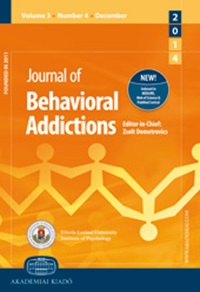血浆瘦素浓度与赌博障碍患者的食物成瘾有关:临床和神经心理学意义
IF 6.6
1区 医学
Q1 PSYCHIATRY
引用次数: 1
摘要
背景数据表明,食欲调节和成瘾性障碍的神经生物学通路存在重叠。尽管不同的神经内分泌测量与赌博障碍(GD)和食物成瘾(FA)有关,但食欲调节激素如何与这两种实体的共同发生有关仍然不完全清楚。目的比较GD、合并FA和不合并FA患者血浆ghrelin、leptin、脂联素和肝脏表达抗菌肽2 (LEAP-2)的浓度,探讨GD和FA患者循环激素浓度与神经心理和临床特征之间的关系。方法297例确诊为GD的患者,其中男性占93.6%。所有GD患者都没有终生被诊断为饮食失调。采用耶鲁食物成瘾量表2.0对FA进行评估。所有患者均通过半结构化临床访谈和包括神经心理学任务在内的心理测量测试进行评估。还收集了血液样本,用于测量激素变量和人体测量变量。结果在总样本中,FA+患者23例(7.7%,男性87%)。当与没有FA的参与者相比,FA+的参与者表现出更高的身体质量指数(BMI) (p <0.001)和瘦素浓度,调整BMI后(p = 0.013)。在FA患者中,瘦素浓度与冲动性、较差的认知灵活性和较差的抑制控制呈正相关。其他内分泌指标在两组之间没有差异。讨论和结论本研究提示瘦素与GD和FA的共同发生有关。在这些患者中,瘦素浓度与临床和神经心理学特征有关,如某些领域的冲动和认知表现。本文章由计算机程序翻译,如有差异,请以英文原文为准。
Plasma concentration of leptin is related to food addiction in gambling disorder: Clinical and neuropsychological implications
Abstract Background Data implicate overlaps in neurobiological pathways involved in appetite regulation and addictive disorders. Despite different neuroendocrine measures having been associated with both gambling disorder (GD) and food addiction (FA), how appetite-regulating hormones may relate to the co-occurrence of both entities remain incompletely understood. Aims To compare plasma concentrations of ghrelin, leptin, adiponectin, and liver-expressed antimicrobial peptide 2 (LEAP-2) between patients with GD, with and without FA, and to explore the association between circulating hormonal concentrations and neuropsychological and clinical features in individuals with GD and FA. Methods The sample included 297 patients diagnosed with GD (93.6% males). None of the patients with GD had lifetime diagnosis of an eating disorder. FA was evaluated with the Yale Food Addiction Scale 2.0. All patients were assessed through a semi-structured clinical interview and a psychometric battery including neuropsychological tasks. Blood samples to measure hormonal variables and anthropometric variables were also collected. Results From the total sample, FA was observed in 23 participants (FA+) (7.7% of the sample, 87% males). When compared participants with and without FA, those with FA+ presented both higher body mass index (BMI) ( p < 0.001) and leptin concentrations, after adjusting for BMI ( p = 0.013). In patients with FA, leptin concentrations positively correlated with impulsivity, poorer cognitive flexibility, and poorer inhibitory control. Other endocrine measures did not differ between groups. Discussion and conclusions The present study implicates leptin in co-occurring GD and FA. Among these patients, leptin concentration has been associated with clinical and neuropsychological features, such as impulsivity and cognitive performance in certain domains.
求助全文
通过发布文献求助,成功后即可免费获取论文全文。
去求助
来源期刊

Journal of Behavioral Addictions
PSYCHIATRY-
CiteScore
12.30
自引率
7.70%
发文量
91
审稿时长
20 weeks
期刊介绍:
The aim of Journal of Behavioral Addictions is to create a forum for the scientific information exchange with regard to behavioral addictions. The journal is a broad focused interdisciplinary one that publishes manuscripts on different approaches of non-substance addictions, research reports focusing on the addictive patterns of various behaviors, especially disorders of the impulsive-compulsive spectrum, and also publishes reviews in these topics. Coverage ranges from genetic and neurobiological research through psychological and clinical psychiatric approaches to epidemiological, sociological and anthropological aspects.
 求助内容:
求助内容: 应助结果提醒方式:
应助结果提醒方式:


